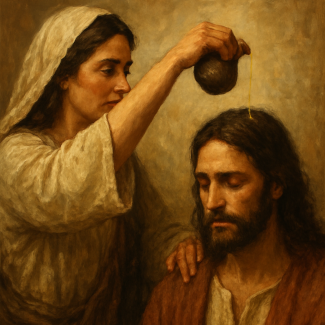How Many Times Was Jesus Anointed?
Before we get into how many times Jesus was anointed I want to talk about the word Messiah. Messiah translates as “anointed one”. The word “Christ” is the Greek word for Messiah or the anointed one. The anointed one is the chosen one by God. In the Old Testament, anointing a person was a process to demonstrate that they were chosen by God. Prophet, priest, and king were anointed before assuming the position.
The prophet Samuel anointed both Saul and David as kings of Israel (1 Samuel 10:1; 16:13). Elijah anointed Elisha to succeed him as Israel’s prophet (1 Kings 19:16). Moses anointed Aaron as the first high priest of Israel (Leviticus 8:12). Almost all prophet have prophesied the coming of a Messiah, a Deliverer, chosen by God to redeem Israel (Isaiah 42:1; 61:1–3).

How many Times was Jesus anointed?
A raw reading of the Gospels has Jesus being anointed 3 times.
1. Early in Jesus’s ministry: (Luke 7:36-50) Is an a account, a sinful woman anoints Jesus’ feet with perfume and wipes them with her hair while he dines at the home of Simon the Pharisee. Simon inwardly complains that if Jesus was a prophet he would know this woman was a sinner. Jesus teaches the parable of The Creditor had Two Debtors. Jesus forgives her sins.
2. (John 12:1-11) Six days before his death. Jesus travels to Bethany. There a dinner is prepared for Jesus. Mary of Bethany, the sister of Lazarus, anoints Jesus’ feet with expensive spikenard. Judas Iscariot complains that this about how that could have been sold an given to the poor. Jesus says this is for the day of his burying. And how the poor will be with you always.
3. (Matthew 26:6-13) and (Mark 14:3-9) There is no argument that recorded events in Matthew and Mark are the same even. While in Bethany at Simon the leper’s house. An unnamed woman breaks an alabaster jar and pours expensive perfume on Jesus’ head. The disciples complain how the alabaster box could have been sold and given to the poor. Jesus says she did it for his burial.
There were only Two.
It is my position that Jesus was anointed only two times. Once early in his ministry as reported by Luke. The second time was during that the last week of his life as recorded by Matthew, Mark, and John.
(Luke 7:36-50)
There are a few reasons why I would except Luke as a separate event from the other two.
1) It is reported early in the writings of Luke. Only seven chapters into the story. In chapter 6 Jesus just chose his apostles. The other accounts put their anointings during the last week of his life. Near the end of each of their writings.
2) The Location appears to be in city of Nain or at least in the sounding area. Jesus is in Galilee almost 60 miles from Bethany. In all the other accounts Jesus is in city Bethany, in Judea.
3) There does appear to be a similarity in the name of the person hosting the dinner. It is at the house of a Pharisee, know as Simon the Pharisee. Which does bare a similarity to Simon the Leper, but we must keep in mind that Simon was a very commend name during that time. Two of the apostles were named Simon, Simon Peter and Simon the Zealot. Also Judas Iscariot’s father was named Simon. So it is easy to except that these could be different men.
4) The the concern with the anointing is different. Simon the Pharisee sees this anointing and is not concerned the money that was wasted. He is concerned because this woman is a know sinner and if Jesus was a prophet he should know that. The concern in all the other accounts is about how this expensive oil could have been sold and given to the poor.
5) Jesus response with the parable of The Creditor had Two Debtors . Which is about two men who owed a debt. One owned more money then the other. Jesus asked who was more grateful. Simon says the one who was forgiven for more.
6) The reason the woman anointed Jesus. In all the other accounts Jesus says this anointing was for his burial. In Luke’s account it done out of respect, humility, and love. The women recognized who Jesus was and honored him.
7) The conclusion is different. In the end Jesus chastises Simon for not doing the customary practice of water to wash the feet and expressed no respect or love to Jesus. The account ends with Jesus forgiving the sins of the woman.
The only similarly to the other accounts is that a woman anoints Jesus. Everything else is different, the location, the people, the reasons, and the conclusions.
Matthew, Mark, and John’s account are about the same event.
It is generally excepted that Jesus is anointed twice in the last week of his life. I will says I do not have a problem with that position. To me it is like spilled milk. I can except that Jesus was anointed twice in the last week of his life. But in my option the evidence does not fully support that.
The Differences
If you begin with the differences it becomes clear to me that they are all the same.
1) John: six days before the Passover. Matthew and Mark: two days before the Passover.
2) John: The feet of Jesus is anointed. Matthew and Mark: The head of Jesus in anointed.
That is it. Only two things that have a real difference in the accounts.
The Similarities
1) It happens in Bethany. All record that the anointing happens in Bethany. Matthew and Mark says it happens at Simon the lepers house, in Bethany. John does not says who’s house the dinner took place at, but he says it happened in Bethany. John leaving out the house owners name does not make these different. It still could have been at Simon’s house in Bethany
2) A woman with an precious ointment anoints Jesus.
Matthew : “… a woman having an alabaster box of very precious ointment …”
Mark : “… a woman having an alabaster box of ointment of spikenard very precious …”
John : “Then took Mary a pound of ointment of spikenard, very costly …”
John’s account still is not a difference. Mary (a woman) takes a very precious (costly) ointment to anoint Jesus. John just gave us the name of the woman.
3) Selling the ointment and giving it to the poor.
Matthew : “For this ointment might have been sold for much, and given to the poor.”
Mark : “For it might have been sold for more than three hundred pence, and have been given to the poor.”
John : “Why was not this ointment sold for three hundred pence, and given to the poor?”
These statements are almost verbatim.
4) How Jesus responds
Matthew : “he said unto them, Why trouble ye the woman? for she hath wrought a good work upon me.”
Mark : “And Jesus said, Let her alone; why trouble ye her? she hath wrought a good work on me.”
John : “Then said Jesus, Let her alone: …”
These statements are almost verbatim.
5) The poor you have with you always.
Matthew : “For ye have the poor always with you; but me ye have not always.”
Mark : “For ye have the poor with you always, and whensoever ye will ye may do them good: but me ye have not always.”
John : “For the poor always ye have with you; but me ye have not always.”
Again these statements are verbatim.
6) Why she anoints Jesus
Matthew : “For in that she hath poured this ointment on my body, she did it for my burial.”
Mark : “She hath done what she could: she is come aforehand to anoint my body to the burying.”
John : “Then said Jesus, Let her alone: against the day of my burying hath she kept this.”
Verbatim, Verbatim, Verbatim.
Conclusion
The only real question you should be asking yourself is… If these were two separate events, then why when the second anointing happened did the disciples still have the same problem with it? Just four days ago Jesus instructed them that he did not have a problem with a woman anointing him with an expensive oil. That the poor were with them always and he was not. That this anointing was for his burial.
I am not sure if you noticed the verse above when Jesus said… “For in that she hath poured this ointment on my body” He did not say she anointed my head or my feet. Jesus said my body. This to me is the scriptures explaining that Jesus was anointed from head to toe. One witness telling us that Jesus’s head was anointed and the other telling us that his feet were anointed.
Six or Two Days
I feel it is clear that Matthew, Mark, and John are all talking about the same event. These are not two separate events. The only reaming question is did the event occur six days before or two days before the Passover. This is not as clear. I lean more toward two days before. John records that Jesus came to Bethany six days before the Passover. He does not say that six days before Jesus was anointed. Leaving room for this event to have happened at a latter date.
Biography:
The Bible. Authorized King James Version, Oxford UP, 1998.
(Matthew 26:6-13), (Mark 14:3-9), (Luke 7:36-50), (John 12:1-11)

